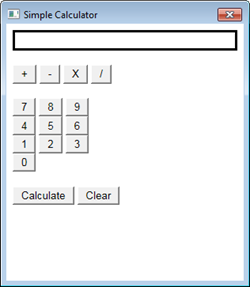
In this tutorial, you build a calculator in which you can perform arithmetic operations (addition, subtraction, multiplication, and division).
You can learn how to:
When you finish, your calculator will look like the following picture:

Minimum Origin Version Required: Origin 2017
| Note: You can download the sample file here. |
As the first step in developing this calculator, you create an HTML page and add equation display box, number input buttons, operator buttons, Calculate button and Clear button to this page.
<!DOCTYPE html> <html> <head> <meta charset="utf-8" /> <meta http-equiv="X-UA-Compatible" content="IE=Edge"/> </head> <body> <!--equation display textbox--> <div id="Equation" style="border:solid;height:20px;"></div> </br> <!--four arithmetic operations buttons--> <div id="Ops"> <input type="button" id="btnPlus" value="+"/> <input type="button" id="btnMinus" value="-"/> <input type="button" id="btnMultiply" value="X"/> <input type="button" id="btnDiv" value="/"/> </div> </br> <!--number input buttons from 0 to 9--> <div id="Num789"> <input type="button" id="btn7" value="7"/> <input type="button" id="btn8" value="8"/> <input type="button" id="btn9" value="9"/> </div> <div id="Num456"> <input type="button" id="btn4" value="4"/> <input type="button" id="btn5" value="5"/> <input type="button" id="btn6" value="6"/> </div> <div id="Num123"> <input type="button" id="btn1" value="1"/> <input type="button" id="btn2" value="2"/> <input type="button" id="btn3" value="3"/> </div> <div id="Num0"> <input type="button" id="btn0" value="0"/> </div> </br> <!--calculation button and clear button --> <div> <input type="button" id="btnCalculate" value="Calculate"/> <input type="button" id="btnClear" value="Clear"/> </div> </body> </html>
| Note: When editing is complete, you can check this page by opening it with any web browser. |
The calculator works as follows:
In order to get your program to work that way, you need to add an onclick event handler to capture a click event from the users’ mouse on the button in the HTML page. This action usually results in a call to a JavaScript function which helps to perform the calculation.
Taking the Calculate button  as an example:
as an example:
Invoke_Cal(). Note that this function will be used to respond to the click button event by onclick event handler mentioned in Step 2.
<script> function Invoke_Cal() {} </script>
Invoke_Cal() will be invoked if the user clicks this button.
<input type="button" id="btnCalculate" value="Calculate" onclick="Invoke_Cal()"/>
onclick event handler inside every button to capture click event and add its corresponding JavaScript functions inside <script>.
In this example, arithmetic operations are performed in OriginC in order to show you how to call OriginC in JavaScript.
In JavaScript, you will use the function window.external.ExtCall to call into OriginC:
window.external.ExtCall(“OriginC Function Name”, Parameter1, Parameter2…)
Note:
|
Now, you can modify the functions inside <script> as follows after you figure out how to call OriginC in JavaScript, and the complete code is available in the HTML sample file.
<script> var PlusOp = "+"; var MinusOp = "-"; var MultiplyOp = "*"; var DivOp = "/"; function Invoke_AddOp(strOp) { var OriginStr = document.getElementById('Equation').innerHTML; //Calling OriginC function AddOp to show the operator symbol in textbox var NewStr = window.external.ExtCall("AddOp", OriginStr, strOp); document.getElementById('Equation').innerHTML = NewStr; } function Invoke_AddNum(NewNum) { var OriginStr = document.getElementById('Equation').innerHTML; //Calling OriginC function AddNum to show the number input in textbox var NewStr = window.external.ExtCall("AddNum", OriginStr, NewNum); document.getElementById('Equation').innerHTML = NewStr; } function Invoke_Cal() { var Str = document.getElementById('Equation').innerHTML; //Calling OriginC function Calculate to get the result of equation var Result = window.external.ExtCall("Calculate", Str); document.getElementById('Equation').innerHTML = Result; } function Invoke_Clear() { //Calling OriginC function Clear to erase the text in textbox document.getElementById('Equation').innerHTML = window.external.ExtCall("Clear"); } </script>
In this section, you edit and execute OriginC code to launch the calculator dialogue in Origin.
#include <Origin.h> #include <..\OriginLab\DialogEx.h> #include <..\OriginLab\HTMLDlg.h>
HTMLDlg
class OriginCalculatorDlg: public HTMLDlg { public: string GetInitURL() { return GetFilePath(__FILE__) + "SimpleCalc.html"; } string GetDialogTitle() { return "Simple Calculator"; } };
calc which launches the calculator dialog.
void calc() { OriginCalculatorDlg dlg; dlg.DoModalEx(GetWindow()); }
calc() function to open the dialog.
In this section, you add methods in your dialog class OriginCalculatorDlg, which are called in JavaScript to perform the basic arithmetic operations.
public:
DECLARE_DISPATCH_MAP
//when clicking any operator string OriginCalculatorDlg::AddOp(string str, string strOp) { return str + " " + strOp + " "; } //when clicking any digits string OriginCalculatorDlg::AddNum(string str, int NewNum) { return str + ftoa(NewNum); } //use LabTalk expression to evaluate double OriginCalculatorDlg::Calculate(string str) { double dd; LT_evaluate(str ,&dd); return dd; } string OriginCalculatorDlg::Clear(void) { return ""; }
public: string AddOp(string str, string strOp); string AddNum(string str, int NewNum); double Calculate(string str); string Clear();
BEGIN_DISPATCH_MAP(OriginCalculatorDlg, HTMLDlg) DISP_FUNCTION(OriginCalculatorDlg, AddOp, VTS_STR, VTS_STR VTS_STR) DISP_FUNCTION(OriginCalculatorDlg, AddNum, VTS_STR, VTS_STR VTS_I4) DISP_FUNCTION(OriginCalculatorDlg, Calculate, VTS_R8, VTS_STR) DISP_FUNCTION(OriginCalculatorDlg, Clear, VTS_STR, VTS_VOID) END_DISPATCH_MAP
Note: The syntax of DISP_FUNCTION should be:
DISP_FUNCTION(User-defined Dialog Class, Function Name, Type of Ouput, Type of Input Type of Input…) in which VTS_BOOL = bool, VTS_I4 = integer, VTS_R8 = double, VTS_STR = string and VTS_VOID = void. |